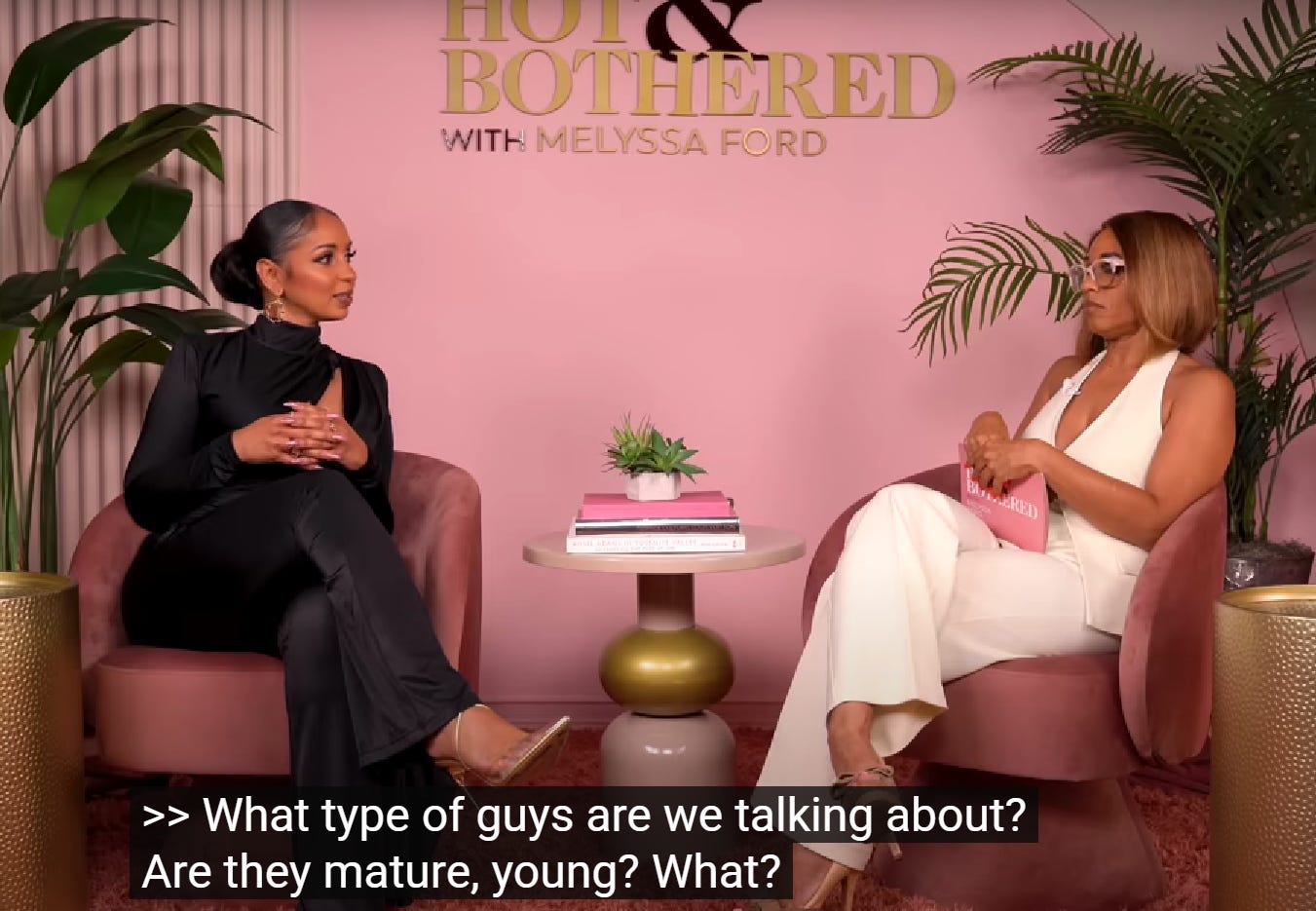Pulse Check: Mya in Conversation with Melyssa Ford
Mya discusses independence, youth, and the white dress
Reflecting on the main takeaways from singer Mya’s recent interview with Melyssa Ford on Ford’s podcast Hot and Bothered.
Pulse Check: Mya & Melyssa Ford on the White Dress, Independence, and Aging Beautifully
Hello, Hunters!
This is Kitty, your favorite voice, and I’m the creator of Killer Instinct, a cultural dispatch for Black diasporic life and sharp media critique. I also host a live internet radio show, Killer Frequency, every Friday at 1 p.m.
If you’re a returning Hunter, thank you so much for being here with me as I grow!
If you’re new: welcome to the hunt! Please take a look around, see what else speaks to you, and plan to join me live on Friday.
Today’s topic is a Pulse Check. Pulse Check is here to help you stay on top of the culture, remain cutting-edge, and keep your instincts sharp. For this Pulse Check, we’re talking about singer Mya’s recent sit-down with Melyssa Ford on her podcast Hot and Bothered.
A little about Mya: she’s an R&B legend whose career spans decades, known for artistry, independence, and longevity. Melyssa Ford is a cultural mainstay of the 2000s, having transitioned from video vixen to radio and podcast personality, and now serving as the host of Hot and Bothered, a space for candid, sometimes raw conversations about love, life, and the industry. Together, the two sat down for a discussion that touched on aging, independence, safety, and the choices women make when they step away from traditional marriage and childbearing scripts. It was a great interview, so I highly recommend checking it out!
Here are a few key takeaways, along with some reflections, to help anchor your viewing.
Takeaway 1: Cultivating an Independent Mindset
Mya’s perspective on independent artistry is invaluable because she has managed such a dynamic, multidisciplinary creative career, encompassing modeling, acting, singing, and dancing. She has sustained her career as an artist for decades while maintaining an immaculate image and reputation along the way. That in itself speaks volumes about how she’s navigated the industry.
In the interview, Mya speaks a lot about being an independent artist. She mentions that this was advice she once received from Prince. To stay independent.
She doesn’t speak against major labels. She acknowledges that they come with pros and cons, and that there are real benefits. Mya herself has walked both sides. She was signed to Interscope earlier in her career, and she’s now releasing music under her own label. Her career has teetered on that line. She has leveraged opportunities from the major label system, while also carving out her own lane when independence served her better.
What stood out to me was how she framed it: regardless of which path you take, cultivating an independent mindset is critical to success.
Mya’s perspective on independent artistry is invaluable because she has managed such a dynamic, multidisciplinary creative career, encompassing modeling, acting, singing, and dancing.
Mya offers advice to musicians seeking a path for themselves today: utilize today’s media landscape to your advantage, build your fan base, and showcase your own work. And then, if you do consider a major, do it from a place of leverage.
At the core, though, Mya makes the case for independence as a mindset. No matter where you land, it’s about being an independent thinker and cultivating an independent mindset. It’s about being an artist who creates for the sake of creativity, staying self-protective, conducting thorough research, cultivating self-awareness, and maintaining control over your career.
Takeaway 2: The Fountain of Youth. Or the Beauty of Age?
Melyssa Ford brings up the idea of Mya’s youth in this interview. She frames it carefully, asking Mya how she feels about the way people — especially men — often comment that she seems to be “aging backwards” or holding on to a certain youthful allure.
What I appreciated about Melyssa’s framing is that she presented the question in a slightly critical way. She asks Mya if she even considers these comments a compliment. That subtle shift taps into the ageism underlying the comment.
Because what does it mean when we equate beauty or allure with youth?
The truth is, Mya looks her age.
She’s in her forties. Forty is not old. But because women are told they lose value so early, the idea of someone in their forties still radiating desirability gets flattened into: she looks so young. It’s a way of skirting around the truth that age itself can be beautiful.
Mya is beautiful, poised, graceful, and self-composed, qualities that often come with age, not despite it. What if the things we’re calling “youthful” are actually the gifts of aging?
That poise, that composure, that presence.
They’re not the absence of age. They’re the evidence of it.
With that disclaimer in mind, I tried to distill the pillars of Mya’s “youthful” allure as she describes it in this interview.
Mya’s Response: Three Pillars of the “Fountain of Youth”
From Mya’s perspective, staying radiant is about living with intention. In the interview, she gestures toward what I’m calling the three pillars of her fountain of youth:
Research
Mya is clear that some aspects of aging are inevitable. That said, she does believe that some signs of aging actually are reversible. She reflects on younger pictures of herself, where she says she feels she looks older in them, because of the toxicity she was allowing in her life that manifested physically for her then. She also emphasizes the importance of learning, conducting research to understand how to care for oneself, and having the discipline to apply that knowledge.
For her, this spans beyond the physical: it’s about spiritual, mental, and professional upkeep. All of that combined contributes to how people interpret her presence now.
Self-Awareness
She stresses the importance of facing yourself honestly — brutally, even. Self-awareness involves recognizing patterns, behaviors, and truths that might otherwise go unnoticed.
That kind of clarity is a practice, and it’s one that allows her to stay grounded while continuing to evolve.
Evolution
Finally, Mya frames longevity as the ability to adapt. It’s about gaining knowledge and clarity through research and self-awareness, and applying those lessons toward actual change.
Evolution, for her, is the ongoing process of becoming, and it’s what keeps her artistry — and her life — fresh, vital, and authentic.
Taken together, these three pillars — research, self-awareness, and evolution — feel like the recipe Mya offers, not just for what some call the “fountain of youth,” but for cultivating wellness and longevity in a deeper sense.
Mya is beautiful, poised, graceful, and self-composed, qualities that often come with age, not despite it.
Takeaway 3: The White Dress
At one point, a video circulated of Mya in a wedding dress — seemingly marrying herself. People speculated wildly, but what she explains here is that it was actually the conceptual video for “The Truth,” a song she wrote with Lucky Daye. The imagery of Mya in the white dress wasn’t about a wedding. It was a critique.
She describes it as a response to the illusions and fantasies that surround marriage and children, patriarchal illusions that frame the white dress as the pinnacle of a woman’s life. By wearing the dress in that way, she flipped the symbol. It became less about fulfilling external expectations and more about asking: what does it mean to commit to myself?
That theme carried into her conversation with Melyssa Ford. Both women are unmarried and childless, and they openly reflect on their feelings about this, the reactions they’ve received, and the choices they’ve made. What I found striking is that Mya doesn’t present herself as closed off to marriage or kids. Rather, she describes herself as open to all things, without searching, hoping, or aiming for a particular outcome.
That perspective connects directly back to the first two takeaways. It’s rooted in the independent mindset she’s cultivated: the confidence, critical thinking, and self-assurance to build a life outside of convention. And it also connects to her so-called youthful allure. Part of what keeps her energy vibrant is that she has chosen a path that doesn’t align with the conventional life stages typically assigned to women.
The white dress becomes a symbol not of what she’s missing, but of what she’s redefined: commitment to herself, freedom from illusions, and the courage to live outside the script.
This Kitty has Claws (i.e., Critique)
And before I wrap, I want to sprinkle a little salt — not to hate, but because I always like to maintain a critical perspective.
At one point in the interview, Melyssa reflected on the comments she has heard men make about Mya’s beauty. And Mya, in her own cute, playful way, asked a pointed question: Are these men mature?
Mya claims she’s not plugged into those conversations, as though she is unaware of who Melyssa is referring to. But let’s be honest. Given Mya’s stature, the demands of her career, and her professional friendship with Melyssa, it’s impossible to believe Mya is truly unaware.
It’s hard not to hear her questions as a jab toward The Joe Budden podcast itself.
Melyssa Ford is the only woman on The Joe Budden podcast, which is not just a male-dominated podcast; it’s a space that often veers into red-pill territory. Joe Budden himself carries a fraught history of allegations and documented violence against women, and the show is known for its ignorance around certain topics. Bringing on voices like Melyssa Ford or Marc Lamont Hill seems like an attempt to elevate the platform’s image, but it doesn’t erase the underlying issues.
So it does leave one wondering: why would Melyssa choose to be there? On one hand, the answer is obvious. It’s a huge platform that elevates her visibility. But as Mya’s question hints, sometimes the trade-offs you make to elevate your platform cost you in allure, in credibility, in reputation.
That doesn’t make Melyssa’s choice “wrong” — but it makes it fair game for critique.
It’s rooted in the independent mindset she’s cultivated: the confidence, critical thinking, and self-assurance to build a life outside of convention.
And one more note, not so much a critique of either woman individually, but of the system around them: who we allow to “age gracefully” still reflects dominant beauty standards. Mya and Melyssa are both light-skinned, thin-bodied women, and in Mya’s case, with more Eurocentric features. Those realities play a role not just in how they’re perceived as beautiful, but also in the staying power they’ve been able to maintain professionally.
This isn’t meant to detract from their brilliance or artistry. It’s worth noting that their ability to be celebrated in this way is shaped not only by their discipline and self-awareness but also by the beauty hierarchies that continue to dominate the culture.
If you enjoyed this Pulse Check, subscribe, share, like, comment — and join me Friday for Killer Frequency live.
Until next time, Hunters, y’all be safe out there.
Further Reading
The Maya Arts and Tech Foundation
Love for Sale (2008)
Killer Instinct is a cultural dispatch on Black diasporic life and sharp media critique. I host a live Internet radio show called Killer Frequency every Friday at 1pm AST—join me. Support, subscribe, and stay sharp 🗡.



